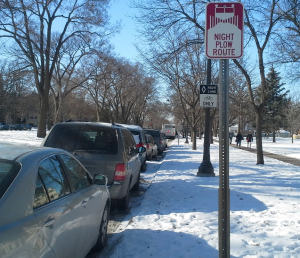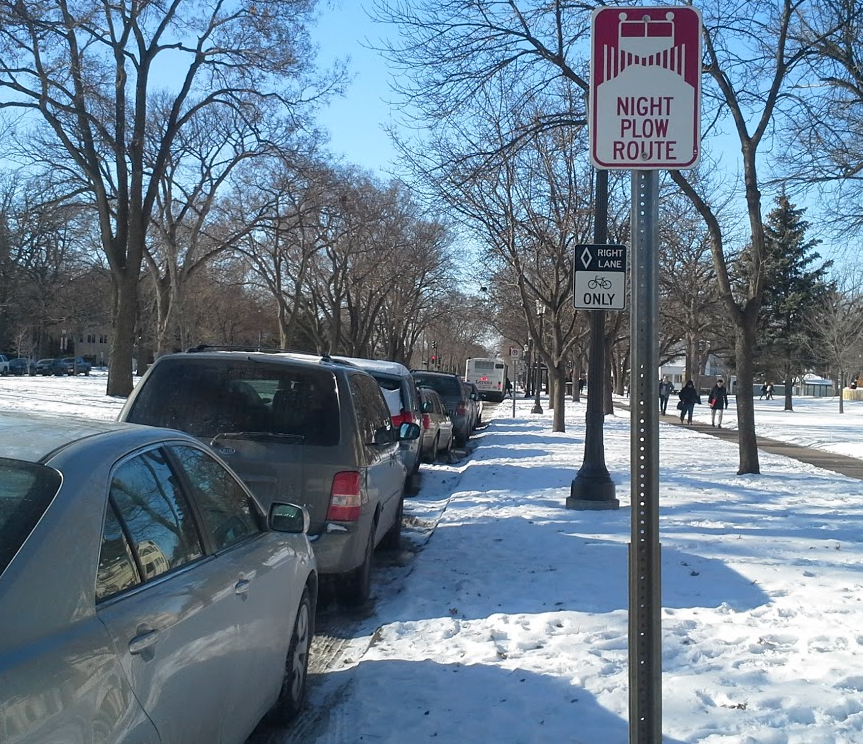Because of recent snowfall, St. Paul has suspended its semi-annual street sweep – which would have affected parking around campus – until spring, according to Dave Hunt, the city’s communication specialist.
William Carter III, Public Safety’s special projects and events manager, said although there are still environmental concerns about the leaves getting into lakes and rivers, the snow makes it impossible to sweep. The city was able to finish some of the sweep in the area around St. Thomas before the snow came.
“There’s not much one can do when the snow comes,” Carter said. “In this area, they got quite a bit of it done.”

Carter said the concern over parking now shifts from street sweeps to snow emergencies.
“The fall leaf cleaning is kind of a training period for people to think about the snow emergency stuff,” he said.
According to the city’s website, snow emergencies are usually declared after the city receives 3 inches or more of snow. Parking restrictions go into effect at 9 p.m., and streets are either night plow or day plow routes. Night plow streets are marked with signs and drivers cannot park on them from 9 p.m. to 8 a.m. Day plow routes are all other unmarked streets that will be plowed from 8 a.m. through 9 p.m.
Many major streets in St. Paul and around the St. Thomas campus are night plow routes, including Summit, Grand, Cleveland and Marshall avenues. Carter said it is important for drivers to know what types of streets they park on, night or day routes.
“Planning ahead is extremely important,” Carter said. “People have to pay attention to it.”
Senior Meghan Anderley, who commutes from Minneapolis, said she does not know much about the regulations in St. Paul now but plans to learn more about them when necessary.
“There hasn’t been much snow yet, so my plan is kind of to figure it out once it happens,” Anderley said. “Parking’s a hassle, but if you follow the rules and you just give yourself enough time, I think it’s doable for everyone.”
To know when a snow emergency is declared, Carter said drivers should sign up for the city’s text message system, which will send them a message when a snow emergency is in place. In addition, Carter suggested students follow Public Safety’s Twitter account, which will post about snow emergencies as well.
If a car is parked on a street during the plow time, the driver can be ticketed or his or her car may be towed. The city’s website lists parking tickets as $56. It costs $209 to get a car out of the impound lot if it is towed, with an additional fee of $15 for every day it spends in the lot. Carter said the city is more likely to tow a car in a snow emergency than during a street sweep.
“Sometimes the cars are parked in such ways that they just need to have them moved,” he said. “It’s worth it to go out into the cold and move your car versus paying the fine.”
In snow emergencies, Carter said the St. Thomas parking regulations on campus are still enforced.
Senior Kevin Mee, who lives off campus and parks on residential streets, said opening up the St. Thomas lots would make the process easier for students.
“It’d be a nice added feature to be able to park on campus for free during snow emergencies,” Mee said.
However, Carter said when the city declares a snow emergency, St. Thomas lots need to be empty so the areas can be plowed as well.
Though Mee finds it inconvenient to move his car, he said he knows doing so will makes things more convenient for him later.
“I know it will make it easier to park there when there’s not a snow emergency,” Mee said.
Despite the inconvenience, Carter said drivers need to pay attention to where they’re parking and be conscious of the reasons for snow emergency regulations. He said they are in place to clear a path first for emergency vehicles and then for other vehicles as well.
“That’s the trade-off for having a car,” Carter said. “What it’s about again is community responsibility.”
Rebecca Mariscal can be reached at mari2162@stthomas.edu.



